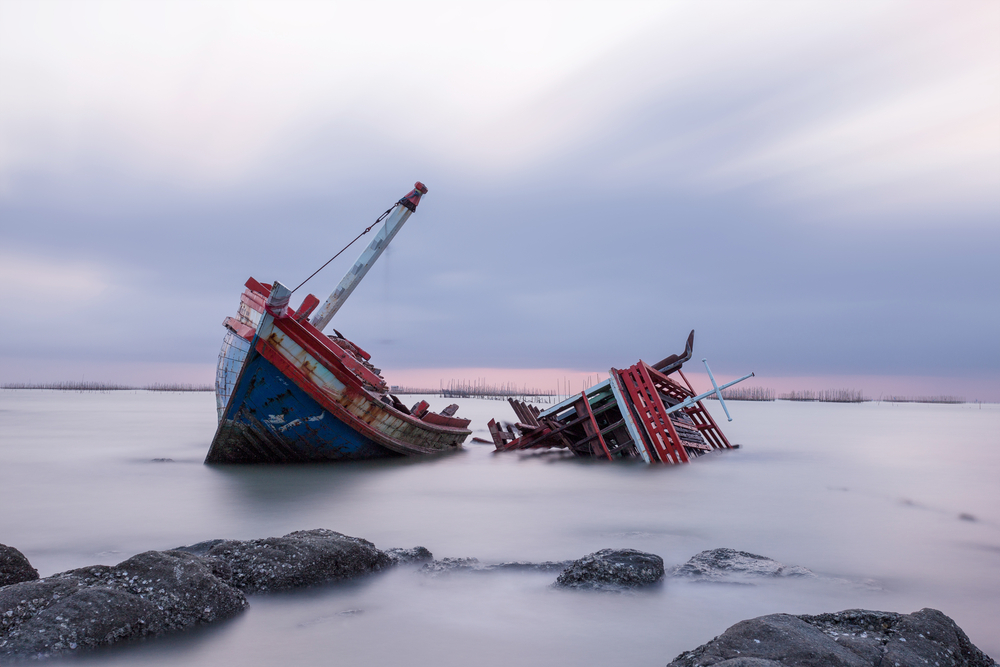What Are Eerie Ghost Ships and How Are They Impacting The Environment?
Posted on Categories Discover Magazine

The unnerving legend of the merchant ship Mary Celeste has persisted for more than 150 years. In late 1872, the ship left New York. About a month later, it was spotted near the Azores, just bobbing along. The crew on a passing ship sent out several unanswered signals. Sensing something was amiss, a few approached in a lifeboat.
The surprised sailors found the Mary Celeste abandoned. There were no signs of life — or death. The ship’s wheel was eerily spinning on its own, and everything was left in place. The captain’s logbook had a typical, mundane entry from 10 days prior. Food was safely stored. Weather gear was untouched. Historians still debate why the people vanished, and the Mary Celeste has come to exemplify “ghost ships.”
What Are Ghost Ships?
(Credit:Raisa Nastukova/Shutterstock)
Ghost ships are vessels that are abandoned, sometimes intentionally. Environmental officials refer to them as abandoned and derelict vessels (ADVs), and they warn they are an environmental threat and safety hazard. They also advise the number of ADVs are increasing, and it’s not just happening in the open seas but in crowded waterways.
Why Are There Ghost Ships in the Ocean?
Ghost ships have been seen in U.S. rivers, lakes, channels and coastal waters. Why would someone simply abandon a boat? Some boats are lost in hurricanes or other inclement weather. In some cases, a boat runs into mechanical trouble and is abandoned by the crew. But boats are often abandoned due to financial reasons.
Boat maintenance can cost 10 percent of the boat’s overall cost each year. Docking the boat in a slip can add on as much as $5,000 per year. When boats start needing work, some owners opt to abandon them rather than dispose of them properly.
(Credit:Mod-X/Shutterstock)
Many boats in the past 50 years have been made of fiberglass, so they aren’t eligible for scrap metal recycling programs that could defray the cost of disposal. Instead, disposal costs deter some owners from properly discarding their vessel. Rather than pay, some owners avoid registering their boats with local authorities so they can simply abandon the boat without it being traced to them.
Intentionally abandoning a boat might involve tying it to a dock and sneaking away. Some boat owners might drive deep into a waterway and then leave it floating. Others might try to intentionally sink their boat. Local or Federal officials are then tasked with removing the vessel.
Read More: Preserved Sunken Ship Found in Shipwreck Alley After 120 Years
How Many Ghost Ships Are There?
State and federal agencies don’t always have the resources to fish abandoned boats from their waterways. In a federal survey, 14 U.S. coastal states reported they identified more than 5,600 ghost ships between 2013 to 2016. But only about 53 percent were removed.
Survey respondents said that budget woes weren’t the only reason they couldn’t recover ghost ships. Many states also had vague policies that made it unclear who should remove the vessel and under which conditions.
Fishing ghost ships out of waterways is costly. In 2021, the Environmental Protection Agency (EPA) worked with the California Department of Fish and Wildlife to remove an oil-leaking boat from a waterway in Lake Tahoe.
The 40-foot boat was about 300 feet from shore, and authorities saw it as both an environmental and a safety hazard. It cost $20,000 to remove. They eventually identified the boat’s owner but learned he was recently deceased. His next of kin, not surprisingly, has no interest in paying for the boat to be properly disposed of.
Read More: Shackleton’s Ship Found After a Century-Long Search
Why Are Ghost Ships a Problem?
(Credit: Getty Images/Sjo)
Environmentalists are worried about ghost ships because they don’t just float aimlessly like the Mary Celeste. Many ghost ships sink or run aground in shallow waters. And when they do, they can crush the environment around them. ADVs can destroy coral reefs, mangroves, marshlands, oyster habitats and wetlands.
Either while afloat or under the surface, ghost ships also damage the environment by releasing pollutants. ADVs have leaked chemicals, oils, paint, sewage and other toxins, all of which can contaminate the waters and harm fish, wildlife and their habitats.
Environmental officials also see ghost ships as a safety hazard. Other ships may not expect a sunken ship in a shallow waterway and they could collide. And ADVs that are still afloat can crash into boats, docks and other structures.
Read More: There is Still Time to Save the Coral Reefs
What Can Be Done About Them?
States are increasingly adopting new policies to deal with the ghost ship problem. Some recommend pilot programs that try to recycle fiberglass and increase the chance a boat owner will properly dispose of their unwanted vessel. Others want to develop more stringent registration programs so that boat owners can’t simply abandon their vessel without fear of being found out.
As for the Mary Celeste, the owner was never found. An investigation uncovered that the owner was the missing captain who also brought his wife and young daughter on the trip. With the owner having vanished into thin air, the ship was sold and put back into service. Many considered it a bad luck ship, and it passed through several owners.
In 1882, the Mary Celeste once again became a ghost ship, this time deliberately. The new owner intentionally rammed the ship into a coral reef near Haiti so he could collect insurance money on the cargo. The ship sank and was never recovered.
Read More: No One Knows How Many Shipwrecks Exist, So How Do We Find Them?